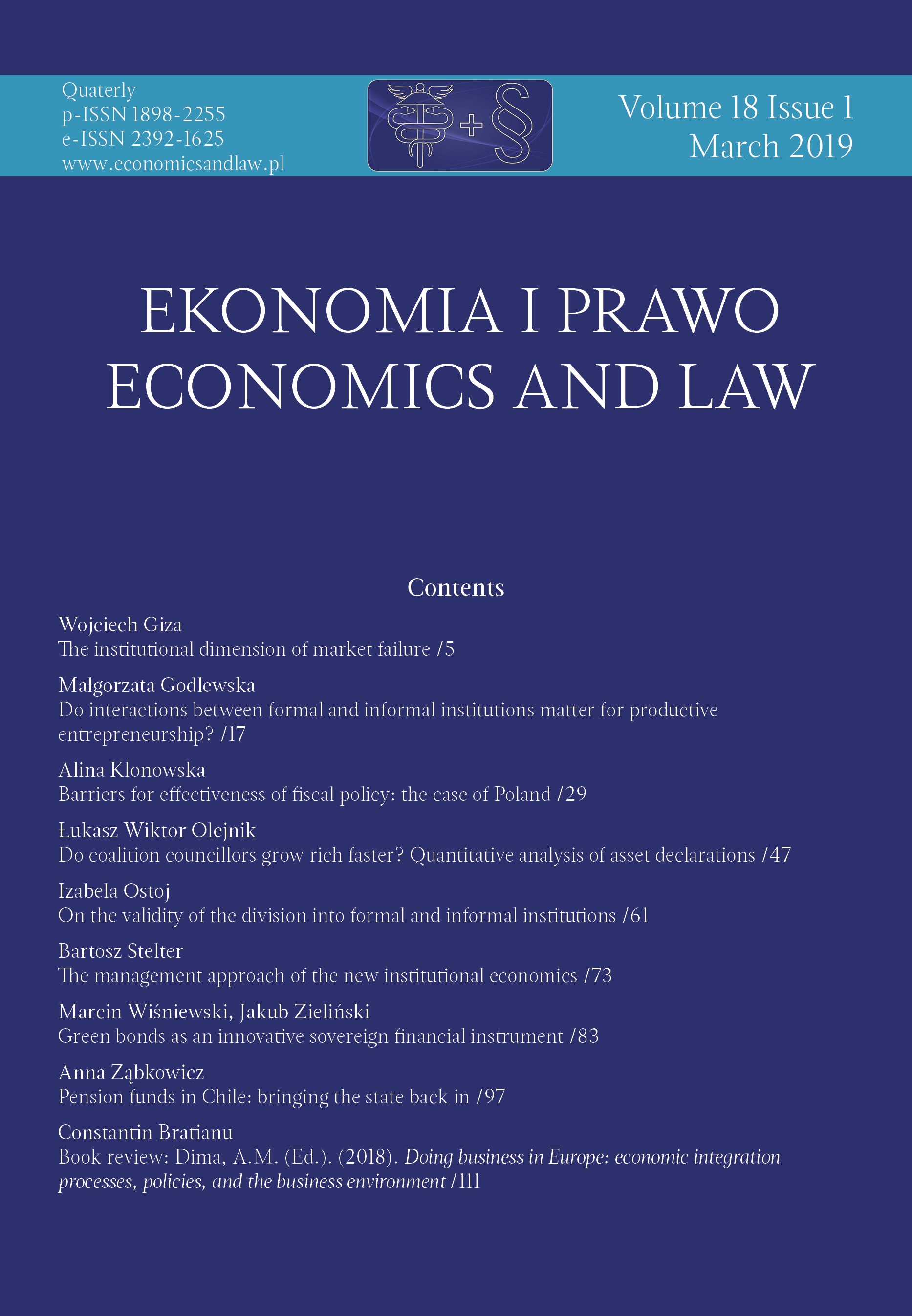Green bonds as an innovative sovereign financial instrument
DOI:
https://doi.org/10.12775/EiP.2019.007Keywords
green bond, financial market, green growth, climate change, public debtAbstract
Motivation: There is a growing awareness of the impact that climate change is having on the world economy and the standards of living. Green bonds (GBs) are relatively new and innovative instruments on the financial market where the capitals are also invested in projects that generate environmental or climate benefits. The newness of this financial instrument could be the main reason behind the scarcity of scientific publications on green bonds; thus, it remains an undeveloped research area. One of the problems is also classifying securities as GBs. Therefore, it is exceedingly important to distinguish labelled green bonds and unlabelled climate-aligned bonds.
Aim: In the article, the authors will present the evolution of the green bonds market and attempt to assess the observed and potential effects of green bonds’ issuances, taking into account governments issues.
Results: Green bonds are the next stage of market growth. In the article, the authors will present the benefits of green bonds and the positive impact that their issuance has on the issuer and on investors’ image as socially responsible entities. Therefore, strong investor demand can lead to oversubscription. Thus, green bonds could be one of the easiest ways to attract investors and potentially increase issuance size which can contribute to lower costs of financing green public tasks.
References
Choudhry, M. (2006). An introduction to bond markets. Hoboken: Wiley & Sons.
Climate Action Programme. (2016). Record $7.5 billion green bond issued by France. Retrieved 20.10.2017 from http://www.climateactionprogramme.org.
Climate Bond Initiative. (2016). Bonds and climate change: the state of market in 2016. Retrieved 20.10.2017 from https://www.climatebonds.net.
Climate Bond Initiative. (2017a). Climate bonds for beginners. Retrieved 20.10.2017 from https://www.climatebonds.net.
Climate Bond Initiative. (2017b). Green Bonds Market 2017. Retrieved 20.10.2017 from https://www.climatebonds.net.
Climate Brief. (2012). Financing the transition to a green economy: their word is their (green) bond? CDC Climate Research, 14.
Ehlers, T., & Packer, F. (2017). Green bond finance and certification. BIS Quarterly Review, September.
Green City Bonds Coalition. (2015). How to issue a green muni bond. The green muni bonds playbook. Retrieved 20.10.2017 from https://www.climatebonds.net.
International Capital Market Association. (2016). Green bond principles. Re-trieved 20.10.2017 from https://www.icmagroup.org.
Jarno, K. (2017). Carbon funds in climate policy. Warszawa: CeDeWu.
Kochetygova, J., & Jauhari, A. (2014). Climate change, green bonds and index investing: the new frontier. Retrieved 20.10.2017 from https://us.spindices.com.
Mackenzie, C., Ascui, F., & Hikish, D. (2009). Investor leadership on climate change. Retrieved 20.10.2017 from https://www.unglobalcompact.org.
Milken Institute. (2018). Growing the U.S. green bond market. Volume 2: actiona-ble strategies and solutions. Retrieved 01.10.2018 from https://www.treasurer.ca.gov.
Ministry of Development and Finance. (2016). Green bond framework. Re-trieved 20.10.2017 from https://www.finanse.mf.gov.pl.
Mishkin, F.S. (2004). The economics of money, banking and financial markets. New York: Pearson Addison Wesley.
Moore, E. (2016). Poland issues world’s first green bonds. Retrieved 20.10.2017 from https://www.ft.com.
OECD & Bloomberg Philanthropies. (2016). Green bonds. Mobilising the debt capital markets for a low-carbon transition: policy perspectives. Retrieved 20.10.2017 from http://www.oecd.org.
Pearce, D.W., Markandya, A., & Barbier, E. (1989). Blueprint for a green econ-omy. London: Routledge.
Socha, J. (2003). Rynek papierów wartościowych w Polsce. Warszawa: Olympus.
United Nation World Commission on Environment and Development. (1987). Our common future (Brundtland Report). Retrieved 20.10.2017 from http://www.un-documents.net.
Whiley, A. (2017). Lagos conference to set stage for Nigeria Sovereign Bond. Re-trieved 20.10.2017 from https://www.climatebonds.net.
Wood, D., & Grace, K. (2011). A brief note on the global green bond market. IRI Working Paper, February.
Downloads
Published
How to Cite
Issue
Section
Stats
Number of views and downloads: 2374
Number of citations: 0
